View in other NatureServe Network Field Guides
NatureServe
Montana
Utah
Wyoming
Idaho
Wisconsin
British Columbia
South Carolina
Yukon
California
New York
Common Carp - Cyprinus carpio
State Rank Reason (see State Rank above)
A conservation status rank is not applicable because this species is not a suitable target for conservation activities as a result of being exotic or introduced.
General Description
Common carp are easily recognized by the two barbels or "whiskers" on each side of the mouth, golden-brown coloration and the "saw-toothed" hardened ray in the front of the dorsal and anal fins. The introduction of carp into North America from Asia is considered to be one of the greatest mistakes in the history of American fisheries management by biologists who have documented the widespread loss of native fish and habitat to this aggressive intruder. Carp are a popular food fish in Eurasia, so they were introduced into North America to serve the same function. However, they are not desirable to North American consumers because they are bony, often have an unpalatable taste and because there are more attractive alternatives. There is some commercial fishing for carp, and they can be processed so that the problems with the fine bones between their muscles are eliminated. Carp are also despised because they compete with more desirable sport fishes, muddy the water by their bottom feeding, and reduce the available food for waterfowl by eating submerged plants. They are extremely hardy omnivores, which means that they eat almost anything. Carp can attain a weight of 40 pounds in productive waters. In Montana, carp are widespread in our eastern drainages. They attain their greatest numbers in lakes and reservoirs.
Diagnostic Characteristics
Overall bronze with a dark brown to olive green back and yellowish underside. Some individuals, called mirror carp, have enlarged scales scattered over the body with bare patches in between. Leather carp are scaleless. From Scott and Crossman (1973), Jester (1974), and Pflieger (1975): adult length 12-25 in (30.5-63.5 cm) or more; large individuals may reach 20-60 lbs (9.1-27.2 kg); two barbels on each side of upper jaw, posterior pair more conspicuous; relatively small, toothless mouth, with the upper jaw slightly protruding; throat teeth 1,1,3-3,1,1, with teeth in main row broad and molar-like; lateral line complete, with 35 to 38 scales; one long dorsal fin with 17-21 soft rays, and a stout saw-toothed spine in front of dorsal and anal fins; pectoral fins with 14-17 rays; pelvic fins thoracic, originating beneath origin of dorsal fin, 8 or 9 rays; 1 anal fin with 5 branched rays; scales cycloid, large, thick; 35-36 vertebrae; 21-27 gill rakers on first gill arch; color variable: back and sides olivaceous, gold, greenish-olive, reddish-brown, or blackish-red, silver or yellowish-white below; fins dusky, often with red on tail fin and yellow or orange on lower fins; peritoneum gray, often more or less speckled.
Species Range
Montana Range
Range Descriptions
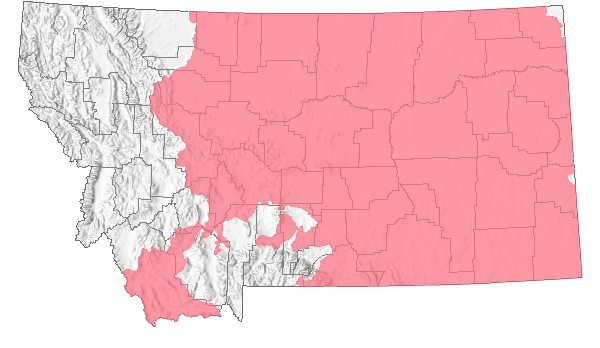
 Non-native
Non-native
Range Comments
Native Range: Eurasia (Page and Burr 1991; Balon 1995). Balon (1995) found that Cyprinus carpio evolved in the Caspian Sea, then migrated naturally to the Black and Aral Seas, east to eastern mainland Asia and west as far as the Danube River.
This species has been introduced into every state in the lower U.S., including Hawaii (Devick 1991), Guam and Puerto Rico. Carp is only established in the Florida panhandle. It does not appear to be established in South Florida.
In Montana, carp are widespread in our eastern drainages. A couple of locations where carp have been noted on the west side of the continental divide (Clark Fork and Bitterroot Drainages) have been eradicated, contained or have died out.
For maps and other distributional information on non-native species see:
Nonindigenous Aquatic Species Database from the U.S. Geological Survey
Invasive Species Habitat Tool (INHABIT) from the U.S. Geological Survey
Invasive Species Compendium from the Centre for Agriculture and Bioscience International (CABI)
EDDMapS Species Information EDDMapS Species Information
Observations in Montana Natural Heritage Program Database
Number of Observations: 3192
(Click on the following maps and charts to see full sized version)
Map Help and Descriptions
Relative Density
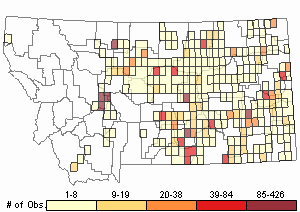
Recency
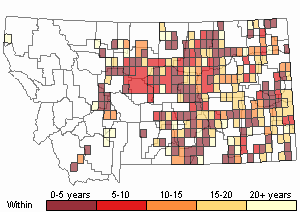

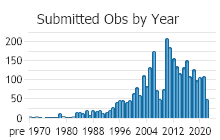
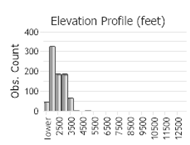 (Observations spanning multiple months or years are excluded from time charts)
(Observations spanning multiple months or years are excluded from time charts)
Migration
May migrate into tributary streams in the summers to spawn.
Habitat
Primarily lakes and reservoirs, where it seeks moderately warm water and shallows. Also rivers, where it prefers pools and backwaters. Congregates in areas of organic enrichment, such as sewage outfalls. Tolerates turbid water and low dissolved oxygen; avoids cold and swift, rocky streams. (Holton 2003) Spawns in shallow weedy areas (Brown 1971).
Food Habits
An omnivorous feeder with vegetation and detritus making up bulk of diet. May feed on any available aquatic organism including eggs of sportfish. Larval common carp feeds primarily on zooplankton. In its native range, juveniles and adults feed on benthic organisms (e.g., chironomids, gastropods and other larval insects), vegetation, detritus and plankton (e.g., cladocerans, copepods, amphipods, mysids). Feeding habits are similar in the U.S., where the diet is composed of organic detritus (primarily of plant origin), chironomids, small crustaceans, and gastropods (Summerfelt et al. 1971; Eder and Carlson 1977; Panek 1987). Will stir up bottom and cause muddied waters while feeding (Gould, personal communication, Brown 1971).
Ecology
In the U.S., the common carp is more abundant in manmade impoundments, lakes, and turbid sluggish streams receiving sewage or agricultural runoff, and less abundant in clear waters or streams with a high gradient (Pflieger 1975; Trautman 1981; Ross 2001; Boschung and Mayden 2004). Young of year carp in Missouri River Study showed a preference for pool and backwater habitat. Considered ecological disaster in North America. The common carp is regarded as a pest fish because of its widespread abundance and because of its tendency to destroy vegetation and increase water turbidity by dislodging plants and rooting around in the substrate, causing a deterioration of habitat for species requiring vegetation and clean water (Cahoon 1953). May reproduce with goldfish causing hybrids. Schools in large numbers multiplying the effects of the destruction on habitats.
Reproductive Characteristics
Sexually mature in 2-3 yrs. Spawns May-July in most Montana waters. Incubation: 12-20 days (Brown 1971). Spawned mid- June-July in middle Missouri River with late June-early July peak.
Management
Carp have been the target of large eradication projects in several states that have generally only temporarily reduced populations. Stocked ponds with outlets to nearby rivers can be poisoned to prevent their unintentional spread. Once established in a water body, common carp is difficult and expensive to eliminate (e.g., Cahoon 1953). DeVaney et al. (2009) performed ecological niche modeling to examine the invasion potential for common carp and three other invasive cyprinids (grass carp Ctenopharyngodon idella, black carp Mylopharyngodon piceus, and tench Tinca tinca). The majority of the areas where common carp have been collected, stocked, or have become established had a high predicted ecological suitability for this species.
Contact information for Aquatic Invasive Species personnel:Montana Fish, Wildlife, and Parks Aquatic Invasive Species staffMontana Department of Natural Resources and Conservation's Aquatic Invasive Species Grant ProgramMontana Invasive Species Council (MISC)Upper Columbia Conservation Commission (UC3)Useful Links:Central and Eastern Montana Invasive Species TeamMontana Invasive Species websiteAquatic Invasive SpeciesStewardship Responsibility
Threats or Limiting Factors
Tolerates turbid water and low dissolved oxygen; avoids cold and swift, rocky streams. (Holton 2003). So, higher flows and colder water temperatures are a limiting factor for further spread in western Montana. Although, warming rivers with carp populations on the east side of the divide may cause carp to further expand their distribution upstream.
References
- Literature Cited AboveLegend:
 View Online Publication
View Online Publication Balon, E.K. 1995. Origin and domestication of the wild carp, Cyprinus carpio: from Roman gourmets to the swimming flowers. Aquaculture, 129:3-48.
Balon, E.K. 1995. Origin and domestication of the wild carp, Cyprinus carpio: from Roman gourmets to the swimming flowers. Aquaculture, 129:3-48. Boschung, H.T., Jr., and R.L. Mayden. 2004. Fishes of Alabama. Smithsonian Books, Washington, DC.
Boschung, H.T., Jr., and R.L. Mayden. 2004. Fishes of Alabama. Smithsonian Books, Washington, DC. Brown, C.J.D. 1971. Fishes of Montana. Bozeman, MT: Big Sky Books/Montana State University. 207 p.
Brown, C.J.D. 1971. Fishes of Montana. Bozeman, MT: Big Sky Books/Montana State University. 207 p. Cahoon, W.G. 1953. Commercial carp removal at Lake Mattamuskeet, North Carolina. Journal of Wildlife Management 17(3):312-317.
Cahoon, W.G. 1953. Commercial carp removal at Lake Mattamuskeet, North Carolina. Journal of Wildlife Management 17(3):312-317. DeVaney, S.C., K.M. McNyset, J.B. Williams, A.T. Peterson, and E.O. Wiley. 2009. A tale of four 'carp': invasion potential and ecological niche modeling. PLoS ONE 4(5): e5451.
DeVaney, S.C., K.M. McNyset, J.B. Williams, A.T. Peterson, and E.O. Wiley. 2009. A tale of four 'carp': invasion potential and ecological niche modeling. PLoS ONE 4(5): e5451. Devick, W. S. 1991. Patterns of introductions of aquatic organisms to Hawaiian freshwater habitats. Pages 189-213 in New directions in research, management and conservation of Hawaiian freshwater stream ecosystem. Proceedings freshwater stream biology and fisheries management symposium. Department of Land and Natural Resources, Division of Aquatic Resources, Honolulu, Hawaii.
Devick, W. S. 1991. Patterns of introductions of aquatic organisms to Hawaiian freshwater habitats. Pages 189-213 in New directions in research, management and conservation of Hawaiian freshwater stream ecosystem. Proceedings freshwater stream biology and fisheries management symposium. Department of Land and Natural Resources, Division of Aquatic Resources, Honolulu, Hawaii. Eder, S. and C.A. Carlson. 1977. Food habits of carp and white suckers in the South Platte and St. Vrain Rivers and Goosequill Pond, Weld County, Colorado. Transactions of the American Fisheries Society 106: 339-349.
Eder, S. and C.A. Carlson. 1977. Food habits of carp and white suckers in the South Platte and St. Vrain Rivers and Goosequill Pond, Weld County, Colorado. Transactions of the American Fisheries Society 106: 339-349. Holton, G.D. and H.E. Johnson. 2003. A field guide to Montana fishes. 3rd edition. Montana Fish, Wildlife & Parks, Helena, MT. 95 pp.
Holton, G.D. and H.E. Johnson. 2003. A field guide to Montana fishes. 3rd edition. Montana Fish, Wildlife & Parks, Helena, MT. 95 pp. Jester, D.B. 1974. Life history, ecology, and management of the carp, (Cyprinus carpio) (Linnaeus), in Elephant Butte Lake. New Mexico State University of Agriculture Experiment Station Research Report No. 273. 80 pp.
Jester, D.B. 1974. Life history, ecology, and management of the carp, (Cyprinus carpio) (Linnaeus), in Elephant Butte Lake. New Mexico State University of Agriculture Experiment Station Research Report No. 273. 80 pp. Lee, D.S., C.R. Gilbert, C.H. Hocutt, R.E. Jenkins, D. E. McAllister, J. R. Stauffer, Jr. 1980. Atlas of North American freshwater fishes. North Carolina State Musuem of Natural History. 867 p.
Lee, D.S., C.R. Gilbert, C.H. Hocutt, R.E. Jenkins, D. E. McAllister, J. R. Stauffer, Jr. 1980. Atlas of North American freshwater fishes. North Carolina State Musuem of Natural History. 867 p. Page, L.M. and B.M. Burr. 1991. A field guide to freshwater fishes. The Peterson Field Guide Series, Houghton Mifflin Co., Boston. 432 pp.
Page, L.M. and B.M. Burr. 1991. A field guide to freshwater fishes. The Peterson Field Guide Series, Houghton Mifflin Co., Boston. 432 pp. Panek, F.M. 1987. Biology and ecology of carp. pp. 1-15. in: Cooper E.L. (ed.) Carp in North America. Bethesda, Md., American Fisheries Society.
Panek, F.M. 1987. Biology and ecology of carp. pp. 1-15. in: Cooper E.L. (ed.) Carp in North America. Bethesda, Md., American Fisheries Society. Pflieger, W. L. 1975. The Fishes of Missouri. Missouri Department of Conservation, Jefferson City. 343 pp.
Pflieger, W. L. 1975. The Fishes of Missouri. Missouri Department of Conservation, Jefferson City. 343 pp. Ross, S.T. 2001. Inland Fishes of Mississippi. University Press of Mississippi, Jackson, Mississippi. 624 pp.
Ross, S.T. 2001. Inland Fishes of Mississippi. University Press of Mississippi, Jackson, Mississippi. 624 pp. Scott, W.B. and E.J. Crossman. 1973. Rainbow trout, Kamloops trout, Steelhead trout Salmo gairdneri Richardson. pp. 184-191. In: Freshwater fishes of Canada. Ottawa, Canada: Fisheries Research Board of Canada, Bulletin 184. 966 p.
Scott, W.B. and E.J. Crossman. 1973. Rainbow trout, Kamloops trout, Steelhead trout Salmo gairdneri Richardson. pp. 184-191. In: Freshwater fishes of Canada. Ottawa, Canada: Fisheries Research Board of Canada, Bulletin 184. 966 p. Summerfelt, R.C., P.E. Mauck, and G. Mensinger. 1971. Food habits of the carp, Cyprinus carpio L. in five Oklahoma reservoirs. Proceedings of the Southeastern Association of Game and Fish Commissions 24: 352-377.
Summerfelt, R.C., P.E. Mauck, and G. Mensinger. 1971. Food habits of the carp, Cyprinus carpio L. in five Oklahoma reservoirs. Proceedings of the Southeastern Association of Game and Fish Commissions 24: 352-377. Trautman, M. B. 1981. The fishes of Ohio. Second edition. Ohio State Univ. Press, Columbus. 782 pp.
Trautman, M. B. 1981. The fishes of Ohio. Second edition. Ohio State Univ. Press, Columbus. 782 pp.
- Additional ReferencesLegend:
 View Online Publication
View Online Publication
Do you know of a citation we're missing? Balon, E.K. 1974. Domestication of the Carp, Cyprinus Carpio L., Misc. Publ. Roy. Ontaria Mus. Life Sci. 37 Pp.
Balon, E.K. 1974. Domestication of the Carp, Cyprinus Carpio L., Misc. Publ. Roy. Ontaria Mus. Life Sci. 37 Pp. Barfoot, C.A. 1993. Longitudinal distribution of fishes and habitat in Little Beaver Creek, Montana. M.Sc. Thesis. Bozeman, MT: Montana State University. 66 p.
Barfoot, C.A. 1993. Longitudinal distribution of fishes and habitat in Little Beaver Creek, Montana. M.Sc. Thesis. Bozeman, MT: Montana State University. 66 p. Barfoot, C.A. and R.G. White. 1999. Fish assemblages and habitat relationships in a small northern Great Plains stream. The Prairie Naturalist 31(2):87-107.
Barfoot, C.A. and R.G. White. 1999. Fish assemblages and habitat relationships in a small northern Great Plains stream. The Prairie Naturalist 31(2):87-107. Craig, V.E. 1952. A story of fish production as it applies to Montana. M.Sc. Thesis. Bozeman, MT: Montana State University. 92 p.
Craig, V.E. 1952. A story of fish production as it applies to Montana. M.Sc. Thesis. Bozeman, MT: Montana State University. 92 p. Dieterman, D.J., M.P. Ruggles, M.L. Wildhaber, and D.L. Galat (eds). 1996. Population structure and habitat use of benthic fishes along the Missouri and Lower Yellowstone Rivers. 1996 Annual report of Missouri River Benthic Fish Study PD-95-5832 to U.S. Army Corps of Engineers and U.S. Bureau of Reclamation. 238 p.
Dieterman, D.J., M.P. Ruggles, M.L. Wildhaber, and D.L. Galat (eds). 1996. Population structure and habitat use of benthic fishes along the Missouri and Lower Yellowstone Rivers. 1996 Annual report of Missouri River Benthic Fish Study PD-95-5832 to U.S. Army Corps of Engineers and U.S. Bureau of Reclamation. 238 p. Duncan, M.B. 2019. Distributions, abundances, and movements of small, nongame fishes in a large Great Plains river network. Ph.D. Dissertation. Bozeman, MT: Montana State University. 255 p.
Duncan, M.B. 2019. Distributions, abundances, and movements of small, nongame fishes in a large Great Plains river network. Ph.D. Dissertation. Bozeman, MT: Montana State University. 255 p. Hendricks, P., S. Lenard, D.M. Stagliano, and B.A. Maxell. 2013. Baseline nongame wildlife surveys on the Fort Peck Indian Reservation. Report to the Assiniboine and Sioux Tribes of the Fort Peck Indian Reservation. Montana Natural Heritage Program, Helena, MT. 83 p.
Hendricks, P., S. Lenard, D.M. Stagliano, and B.A. Maxell. 2013. Baseline nongame wildlife surveys on the Fort Peck Indian Reservation. Report to the Assiniboine and Sioux Tribes of the Fort Peck Indian Reservation. Montana Natural Heritage Program, Helena, MT. 83 p. Joslin, Gayle, and Heidi B. Youmans. 1999. Effects of recreation on Rocky Mountain wildlife: a review for Montana. [Montana]: Montana Chapter of the Wildlife Society.
Joslin, Gayle, and Heidi B. Youmans. 1999. Effects of recreation on Rocky Mountain wildlife: a review for Montana. [Montana]: Montana Chapter of the Wildlife Society. Knight, D.E. 1982. Accumulation of dietary methylmercury by Walleye and White Crappie in the Tongue River Reservoir, Montana. M.Sc. Thesis. Bozeman, Montana: Montana State University. 103 p.
Knight, D.E. 1982. Accumulation of dietary methylmercury by Walleye and White Crappie in the Tongue River Reservoir, Montana. M.Sc. Thesis. Bozeman, Montana: Montana State University. 103 p. Montana Department of Fish, Wildlife and Parks. 1989. Northeast Montana Warmwater Ecosystem Investigations: project period 7/1/88 through 6/30/89. Proj.# F-46-R-2; Job# V-e. 21p.
Montana Department of Fish, Wildlife and Parks. 1989. Northeast Montana Warmwater Ecosystem Investigations: project period 7/1/88 through 6/30/89. Proj.# F-46-R-2; Job# V-e. 21p. Montana Fish, Wildlife and Parks. 1989. Hauser Reservoir fisheries management plan: September 1989-September 1994. 16 p.
Montana Fish, Wildlife and Parks. 1989. Hauser Reservoir fisheries management plan: September 1989-September 1994. 16 p. Mullen, J.A. 2007. Spatiotemporal variation of fish assemblages in Montana prairie streams. M.Sc. Thesis. Bozeman, MT: Montana State University. 102 p.
Mullen, J.A. 2007. Spatiotemporal variation of fish assemblages in Montana prairie streams. M.Sc. Thesis. Bozeman, MT: Montana State University. 102 p. Mullins, M.S. 1991. Biology and predator use of cisco (Coregonus artedi) in Fort Peck Reservoir, Montana. M.Sc. Thesis. Bozeman, MT: Montana State University. 68 p.
Mullins, M.S. 1991. Biology and predator use of cisco (Coregonus artedi) in Fort Peck Reservoir, Montana. M.Sc. Thesis. Bozeman, MT: Montana State University. 68 p. Penkal, R.F. 1977. Black bass populations of the Tongue River Reservoir, Montana. M.Sc. Thesis. Bozeman, MT: Montana State University. 111 p.
Penkal, R.F. 1977. Black bass populations of the Tongue River Reservoir, Montana. M.Sc. Thesis. Bozeman, MT: Montana State University. 111 p. Roberts, B.C. 1988. Potential influence of recreational use on Nelson Spring Creek, Montana. M.Sc. Thesis. Bozeman, MT: Montana State University. 79 p.
Roberts, B.C. 1988. Potential influence of recreational use on Nelson Spring Creek, Montana. M.Sc. Thesis. Bozeman, MT: Montana State University. 79 p. Rosenthal, L.R. 2007. Evaluation of distribution and fish passage in relation to road culverts in two eastern Montana prairie streams. M.Sc. Thesis. Bozeman, MT: Montana State University. 78 p.
Rosenthal, L.R. 2007. Evaluation of distribution and fish passage in relation to road culverts in two eastern Montana prairie streams. M.Sc. Thesis. Bozeman, MT: Montana State University. 78 p. Ross, S.T., and W.M. Brenneman. 1991. Distribution of freshwater fishes in Mississippi. Manuscript. Mississippi Department of Wildlife, Fisheries and Parks, Jackson, MS. 548 pp.
Ross, S.T., and W.M. Brenneman. 1991. Distribution of freshwater fishes in Mississippi. Manuscript. Mississippi Department of Wildlife, Fisheries and Parks, Jackson, MS. 548 pp. Sanborn, B.W. 1990. The ecology of Rainbow Trout in the Bighorn River, Montana. M.Sc. Thesis. Bozeman, Montana: Montana State University. 63 p.
Sanborn, B.W. 1990. The ecology of Rainbow Trout in the Bighorn River, Montana. M.Sc. Thesis. Bozeman, Montana: Montana State University. 63 p. Spinelli, J.P. 2010. Spatial and temporal entrainment of fish from Hauser Reservoir, Montana. M.Sc. Thesis. Bozeman, Montana: Montana State University. 107 p.
Spinelli, J.P. 2010. Spatial and temporal entrainment of fish from Hauser Reservoir, Montana. M.Sc. Thesis. Bozeman, Montana: Montana State University. 107 p. Stash, S.W. 2001. Distribution, relative abundance, and habitat associations of Milk River fishes related to irrigation diversion dams. M.Sc. Thesis. Bozeman, MT: Montana State University. 82 p.
Stash, S.W. 2001. Distribution, relative abundance, and habitat associations of Milk River fishes related to irrigation diversion dams. M.Sc. Thesis. Bozeman, MT: Montana State University. 82 p. Stefanich, F.A. 1951. The population and movement of fish in Prickley Pear Creek, Montana. M.Sc. Thesis. Bozeman, Montana: Montana State University. 42 p.
Stefanich, F.A. 1951. The population and movement of fish in Prickley Pear Creek, Montana. M.Sc. Thesis. Bozeman, Montana: Montana State University. 42 p. Stevenson, H.R. 1975. The trout fishery of the Bighorn River below Yellowtail Dam, Montana. M.Sc. Thesis. Bozeman, MT: Montana State University. 67 p.
Stevenson, H.R. 1975. The trout fishery of the Bighorn River below Yellowtail Dam, Montana. M.Sc. Thesis. Bozeman, MT: Montana State University. 67 p. Stringer, A.L. 2018. Status of Northern Pearl Dace and chrosomid dace in prairie streams of Montana. M.Sc. Thesis. Bozeman, MT: Montana State University. 150 p.
Stringer, A.L. 2018. Status of Northern Pearl Dace and chrosomid dace in prairie streams of Montana. M.Sc. Thesis. Bozeman, MT: Montana State University. 150 p. Sundeen, D.R. 1968. Abundance and movement of young trout in a portion of the Madison River, Montana. M.Sc. Thesis. Bozeman, Montana: Montana State University. 19 p.
Sundeen, D.R. 1968. Abundance and movement of young trout in a portion of the Madison River, Montana. M.Sc. Thesis. Bozeman, Montana: Montana State University. 19 p. The Nature Conservancy. 1986. Element stewardship abstract for Cyprinus carpio common carp. 12 p.
The Nature Conservancy. 1986. Element stewardship abstract for Cyprinus carpio common carp. 12 p. Trenka, R.J. 2000. Community structure and habitat associations of fishes of the lower Tongue and Powder Rivers. M.Sc. Thesis. Bozeman, MT: Montana State University. 85 p.
Trenka, R.J. 2000. Community structure and habitat associations of fishes of the lower Tongue and Powder Rivers. M.Sc. Thesis. Bozeman, MT: Montana State University. 85 p. Urban, Larry, 2002, Biological Resources Report: Wagner Pit Wetland Restoration Site. Proj. No. STPX 56(50) CN 4645. February 23, 2002. In Wgner Pit WS#13 Upper Yellowstone, Yellowstone County. Fin. Dist. 5 AdminDist 5.
Urban, Larry, 2002, Biological Resources Report: Wagner Pit Wetland Restoration Site. Proj. No. STPX 56(50) CN 4645. February 23, 2002. In Wgner Pit WS#13 Upper Yellowstone, Yellowstone County. Fin. Dist. 5 AdminDist 5. USDI Bureau of Land Management. No date. Fishes of the Miles city, Montana BLM District. Miles City, MT: Miles City BLM District pamphlet. 12 p.
USDI Bureau of Land Management. No date. Fishes of the Miles city, Montana BLM District. Miles City, MT: Miles City BLM District pamphlet. 12 p. Williams, J.R. 2019. Quantifying the spatial structure of invasive Lake Trout in Yellowstone Lake to improve suppression efficacy. M.Sc. Thesis. Bozeman, MT: University of Montana. 66 p.
Williams, J.R. 2019. Quantifying the spatial structure of invasive Lake Trout in Yellowstone Lake to improve suppression efficacy. M.Sc. Thesis. Bozeman, MT: University of Montana. 66 p. Wollitz, R.E. 1958. The effects of certain commercial toxicants on limnology of 3 cold water ponds near Three Forks, Montana. M.Sc. Thesis. Bozeman, MT: Montana State University. 63 p.
Wollitz, R.E. 1958. The effects of certain commercial toxicants on limnology of 3 cold water ponds near Three Forks, Montana. M.Sc. Thesis. Bozeman, MT: Montana State University. 63 p. Wuellner, M.R. 2007. Influence of reach and watershed characteristics on fish distributions in small streams of eastern Montana. M.Sc. Thesis. Bozeman, MT: Montana State University. 80 p.
Wuellner, M.R. 2007. Influence of reach and watershed characteristics on fish distributions in small streams of eastern Montana. M.Sc. Thesis. Bozeman, MT: Montana State University. 80 p. Young, B.A., T.L. Welker, M.L. Wildhaber, C.R. Berry, and D. Scarnecchia (eds). 1997. Population structure and habitat use of benthic fishes along the Missouri and Lower Yellowstone Rivers. 1997 Annual report of Missouri River Benthic Fish Study PD-95-5832 to U.S. Army Corps of Engineers and U.S. Bureau of Reclamation. 207 p.
Young, B.A., T.L. Welker, M.L. Wildhaber, C.R. Berry, and D. Scarnecchia (eds). 1997. Population structure and habitat use of benthic fishes along the Missouri and Lower Yellowstone Rivers. 1997 Annual report of Missouri River Benthic Fish Study PD-95-5832 to U.S. Army Corps of Engineers and U.S. Bureau of Reclamation. 207 p.
- Web Search Engines for Articles on "Common Carp"
- Additional Sources of Information Related to "Fish"





